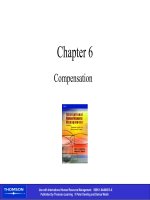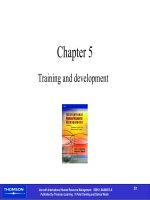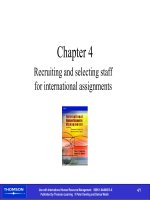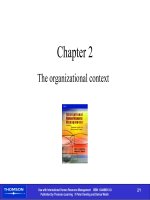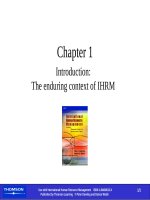International human resource management - Chapter 8 potx
Bạn đang xem bản rút gọn của tài liệu. Xem và tải ngay bản đầy đủ của tài liệu tại đây (1.01 MB, 26 trang )
Use with International Human Resource Management ISBN 1-84480013-X
Published by Thomson Learning © Peter Dowling and Denice Welch
8/1
Chapter 8
HRM in the host country context
Use with International Human Resource Management ISBN 1-84480013-X
Published by Thomson Learning © Peter Dowling and Denice Welch
8/2
Chapter objectives
•
Factors that influence standardization or adaptation of work practices and the role of HR, including host-
country culture and workplace environment, mode of operation, firm size, maturity and international
experience and subsidiary mandate.
(cont.)
Discussion of international HRM issues generally tends to be
biased in the direction of expatriate management, particularly
that of parent-country nationals, partly owing to their strategic
importance. In this chapter, we attempt to redress the balance
by examining HRM issues in subsidiary operations. We cover
the following aspects:
Use with International Human Resource Management ISBN 1-84480013-X
Published by Thomson Learning © Peter Dowling and Denice Welch
8/3
Chapter objectives (cont.)
•
Retaining, developing and retrenching local staff.
•
HR implications of language standardization: HCN
selection, training and promotion on the basis of language
skills.
•
Monitoring HR practices used by foreign subcontractors.
Use with International Human Resource Management ISBN 1-84480013-X
Published by Thomson Learning © Peter Dowling and Denice Welch
8/4
Subsidiary issues
•
Approach to subsidiary management a
function of:
–
The nature of the relationship between units
and ‘parent’
–
The level of equity involved
–
Factors within host-country environments that
facilitate or constrain the transfer of global
management practices and business processes
Use with International Human Resource Management ISBN 1-84480013-X
Published by Thomson Learning © Peter Dowling and Denice Welch
8/5
Standardization of work practices
•
Depends on
–
Receptivity of local workforce to adhere to
corporate norms of behaviour
–
Effectiveness of expatriates as agents of
socialization
–
Whether localization is timely (not just
prompted by cost considerations)
–
Appropriateness to the local environment
Use with International Human Resource Management ISBN 1-84480013-X
Published by Thomson Learning © Peter Dowling and Denice Welch
8/6
Factors influencing
standardization
•
Host-country culture and workplace
environment
•
Mode of operation involved
•
Size and maturity of the firm
•
Relative importance of the subsidiary
Use with International Human Resource Management ISBN 1-84480013-X
Published by Thomson Learning © Peter Dowling and Denice Welch
8/7
Host-country culture
•
Work behaviour is culturally determined
•
Whether corporate culture supersedes or
supplants other ‘cultures’ is a subject of
much debate
•
Often, what is meant by corporate culture
translates into universal work behaviours –
standardisation of work practices
Use with International Human Resource Management ISBN 1-84480013-X
Published by Thomson Learning © Peter Dowling and Denice Welch
8/8
Figure 8-1: The linkage between culture and behaviour
Use with International Human Resource Management ISBN 1-84480013-X
Published by Thomson Learning © Peter Dowling and Denice Welch
8/9
Mode of operation
•
Choice of mode of operation important in
determining standardization of work
practices
•
Ownership and control important factors –
wholly owned subsidiaries provide greater
opportunities for transferring work practices
than in IJVs
Use with International Human Resource Management ISBN 1-84480013-X
Published by Thomson Learning © Peter Dowling and Denice Welch
8/10
Figure 8-2: Factors influencing standardization of work practices
Use with International Human Resource Management ISBN 1-84480013-X
Published by Thomson Learning © Peter Dowling and Denice Welch
8/11
Work standardization
•
The size of the firm, maturity and
international experience also important
•
Motorola in China a case in point:
–
Large size
–
Wealth of international experience
–
Management could draw on these aspects when
entering China
Use with International Human Resource Management ISBN 1-84480013-X
Published by Thomson Learning © Peter Dowling and Denice Welch
8/12
Subsidiary mandate
•
The position a subsidiary holds within the
global ‘family’ is an important aspect when
discussing the transfer of work practices
•
Transferring knowledge and competence is
difficult as subsidiary initiatives are often
not seen as relevant (corporate immune
system)
•
Staff movements can assist here
Use with International Human Resource Management ISBN 1-84480013-X
Published by Thomson Learning © Peter Dowling and Denice Welch
8/13
Global or local work practices?
•
Not a case of ‘either-or’
•
As Huo et al conclude:
“While the recruiting practices used in different
countries are inching toward global
convergence, we expect national cultures to
continue affecting the hiring practices. …
The best IHRM practices ought to be the ones
best adapted to cultural and national
differences”
Use with International Human Resource Management ISBN 1-84480013-X
Published by Thomson Learning © Peter Dowling and Denice Welch
8/14
Retaining local staff
•
The paradox – ‘expense of cheap labour’
•
Poaching of key subsidiary staff
•
Access to skilled labour as important as unit
cost (eg. attraction of India for the IT
industry)
•
The amount and quality of training is an
important consideration
Use with International Human Resource Management ISBN 1-84480013-X
Published by Thomson Learning © Peter Dowling and Denice Welch
8/15
Developing staff
•
Investing in human capital
•
Providing training and career development
can assist in retaining good local staff
•
A fair environment and good management
practices play an important role in countries
such as China
Use with International Human Resource Management ISBN 1-84480013-X
Published by Thomson Learning © Peter Dowling and Denice Welch
8/16
Retrenching staff
•
The reverse of the employment ‘coin’
•
Strategic decisions regarding foreign
operations have HR implications, including
retrenchment
•
Not confined to subsidiary operations but
may affect home base - eg. transferring call
centres from UK and US to India
Use with International Human Resource Management ISBN 1-84480013-X
Published by Thomson Learning © Peter Dowling and Denice Welch
8/17
HR implications of language
standardization
•
Adopting a common corporate language
puts pressure on employees to become
competent in the corporate language
•
Affects
–
Promotion
–
Ability to attend corporate programs and
meetings
–
Availability for international assignments
Use with International Human Resource Management ISBN 1-84480013-X
Published by Thomson Learning © Peter Dowling and Denice Welch
8/18
Figure 8-3: HR implications of language standardization
Use with International Human Resource Management ISBN 1-84480013-X
Published by Thomson Learning © Peter Dowling and Denice Welch
8/19
Figure 8-4: Shadow structure of KONE based on language
Use with International Human Resource Management ISBN 1-84480013-X
Published by Thomson Learning © Peter Dowling and Denice Welch
8/20
Monitoring host country
subcontractors
•
Outsourcing activities to host-country
subcontracting firms requires some
monitoring of HR practices
•
Vocal groups have accused multinationals
of condoning work practices that would not
be permitted in their home countries
Use with International Human Resource Management ISBN 1-84480013-X
Published by Thomson Learning © Peter Dowling and Denice Welch
8/21
HR’s role
•
Drawing up and reviewing codes of conduct
•
Conducting a cost-benefit analysis to justify an
expatriate as a monitor
•
Championing local operators as monitors
•
Being a member of the team who conducts periodic
‘checking’ visits
•
Overseeing external monitors and auditors where used
•
Checking rewards and performance systems take
compliance into consideration
Use with International Human Resource Management ISBN 1-84480013-X
Published by Thomson Learning © Peter Dowling and Denice Welch
8/22
Chapter summary
This chapter has focused on issues relating to HRM and work
practices in the host-country context. We chose four main areas to
examine:
•
The standardization versus adaptation debate as it relates to
subsidiary operations. We identified four inter-related factors
that influence the multinational’s ability to impose or transfer its
preferred work and HR practices:
–
The host-country culture and workplace environment. We looked at the
interplay between values, attitudes and work behavior and the role of
corporate culture in assisting work outcomes.
(cont.)
Use with International Human Resource Management ISBN 1-84480013-X
Published by Thomson Learning © Peter Dowling and Denice Welch
8/23
Chapter summary (cont.)
–
Mode of operation. Managerial discretion to introduce its own practices
is higher in wholly owned subsidiary operations than in IJVs.
Acquisitions may be constrained by the inherited workforce. We also
looked at management contracts as a mode of operation that may
influence standardization of work practices in foreign operations.
–
Firm size, maturity and level of international experience. Firms such as
Motorola can draw upon experience and resources to an extent not
possible for smaller and less-experienced international players.
–
Subsidiary mandate. The position of the subsidiary in the
intraorganizational network and level of interdependence between units
for resources can assist in the transfer of ‘best practice’.
(cont.)
Use with International Human Resource Management ISBN 1-84480013-X
Published by Thomson Learning © Peter Dowling and Denice Welch
8/24
Chapter summary (cont.)
•
Retaining, developing and retrenching local staff. Aspects
such as the paradox of cheap labor, the skill level of the
local workforce and training were examined, along with
poaching of staff and job-hopping. Although our examples
are drawn from Chinese and Indian situations, these issues
are not confined to these two countries.
We also looked at the impact of strategic decisions on
subsidiary operations – such as plant closures and
rationalization – that result in employee retrenchments at the
subsidiary and in the home-country operations.
(cont.)
Use with International Human Resource Management ISBN 1-84480013-X
Published by Thomson Learning © Peter Dowling and Denice Welch
8/25
Chapter summary (cont.)
•
The HR implications of language standardization. The decision to use a corporate language – usually
English – has implications for subsidiary staff in areas such as selection for positions, attendance at
company training programs and promotion.
•
Monitoring the HR practices used by international subcontractors. This discussion opened up a
somewhat contentious issue for multinationals who are expected to monitor the work practices
employed by international subcontractors. Mechanisms used to monitor adherence by these firms to
multinationals’ codes of conduct include using internal agents, such as expatriates or ‘flying’ visits by
headquarters or regional staff, external agents such as local buyers and auditors.
(cont.)




